| | INDEX
People
Fisher, Susan
Pisanello
Ries,
Victor
Russin, Robert
Shagin,
Alex
Somogyi, Marika
Vincze,
Paul
Wacks, Mel
Wiener, Gerta Ries
|  |
| The
Making of a Medal ...
From Conception to Completion Honoring
the induction of Sgt. Leopold Karpeles into
the Jewish-American Hall of Fame
(page 2) 

So
too did the reverse design evolve, based on the fact that Karpeles idolized Abraham
Lincoln. Mel Wacks' first concept was to combine the words of Lincoln with Philadelphia's
Congregation Mikveh Israel, the second oldest Jewish house of worship in the United
States (founded 1738). Just as
Shagin had zoomed in on Karpeles on the obverse, he decided to feature Lincoln's
words on the reverse, and to minimize the synagogue; ultimately the building was
completely eliminated. Beneath Lincoln's letter is a Jewish prayer shawl ("tallit"
in Hebrew), which has several stripes woven into the white material. Interestingly,
the flag motif of the obverse is reflected on the reverse, since the blue and
white striped flag of Israel was modeled after the traditional tallit. 
At
one point the artist considered adding a "coin" of Abraham Lincoln to
the reverse, but this idea was abandoned. 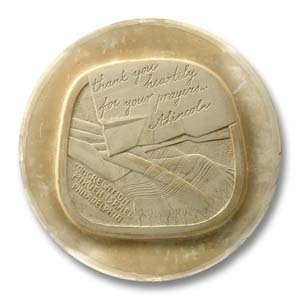
Once
the reverse was completed in clay and then cast in Plaster of Paris, both models
were shipped from Shagin's Los Angeles studio to the MedalCraft Mint in Green
Bay, Wisconsin. The mint reduced the large (over 10 inches diameter) plaster models
to 2 1/8" diameter steel dies, using a 3-dimensional pantograph machine.
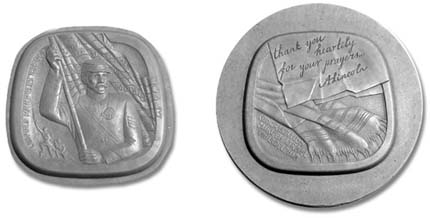
An
impression of each die was made in soft epoxy; after these hardened they were
sent to Hall of Fame Director, Mel Wacks for final review. Soon after the dies
were approved, production of the medals began. 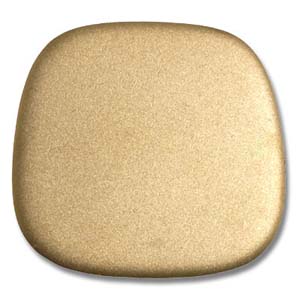
The
Jewish-American Hall of Fame medals are unique since (with few exceptions) they
are not circular, but are a rounded trapezoidal shape as originated by Victor
Ries, designer of the first medal in the series. So production is a little different
than for run-of-the-mill medals. The blanks are made by cutting the unique shapes
out of the bronze or pure silver metal strips, using a giant "cookie cutter."
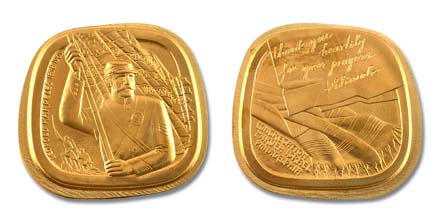
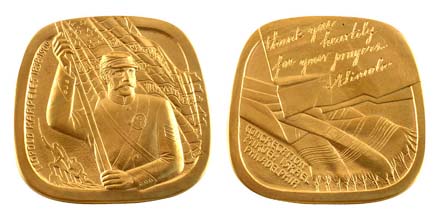
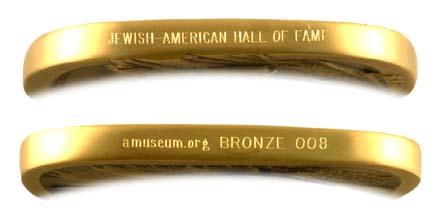
The
blank is then stamped under tons of pressure, imprinting the design and causing
the metal to expand. This must be done 3 or 4 times to bring up all the details.
In between strikes, the medals must be heat treated to reduce hardness. The excess
metal must eventually be trimmed off by the same "cookie cutter" used
in the first step. The relief designs are then oxidized and the high points are
gently polished, to produce an antique patina. Finally, the edges are engraved
with "JEWISH-AMERICAN HALL OF FAME," "amuseum.org," the metal
and serial number. 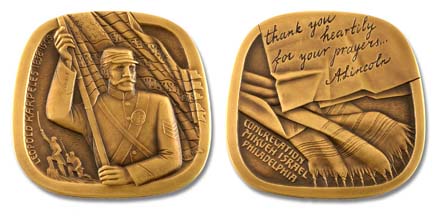
No
more than 999 bronze and 499 pure silver Leopold Karpeles medals will be struck,
measuring over 2" diameter and weighing about 3 oz. each. Also, a maximum
of 49 10kt. gold medals will be made by the ancient lost-wax casting method. For
availability and prices, contact the non-profit Jewish-American Hall of Fame,
5189 Jeffdale Avenue, Woodland Hills, CA 91364 or visit
the shop. Click
here to read biography of Leopold Karpeles
<<
Previous Page
|